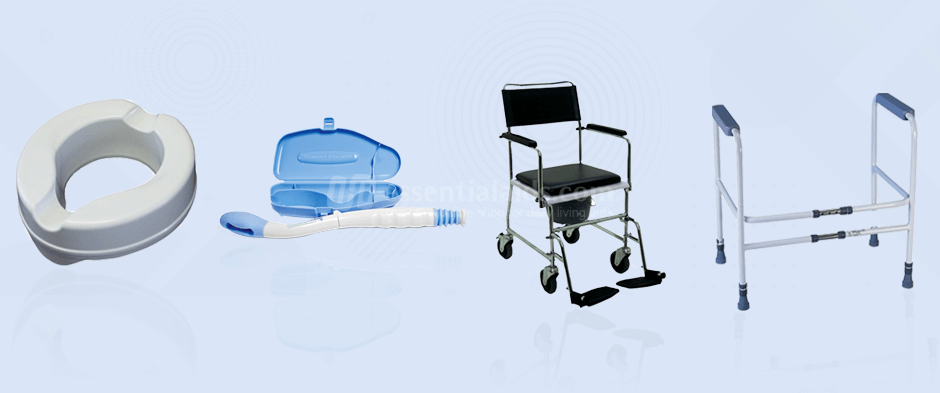
Your Buying Guide for Toilet Assistance Products
Sally Madeley-Carr, OT16 Jan 2020
Losing one's balance or strength because of a medical condition can make using the toilet more difficult. Whether it's just being unsteady on one's feet, or lacking the strength to get up and down from a sitting position, unforeseen challenges can arise.
In more severe situations, a loss of mobility may even make it difficult to make the journey to and from the bathroom.
While discussing personal toileting arrangements is not high on anyone's list of fun activities, it is important to consider practical steps which can help. Many find the subject embarrassing and are often reluctant to seek help or advice.
As ever, the first stage is to recognize the problem so action can be taken to remedy it. Elderly people living alone are particularly vulnerable and not all have someone with whom to discuss private matters like using the toilet.
Council and NHS Support
If you are struggling with your toileting, we advise you to speak to your GP as a first port of call. They may refer you to a 'continence advisor': a specialist nurse who can assess your individual situation and suggest solutions.
You may also want to discuss things with an occupational therapist. These professionals offer advice on specific pieces of equipment which might help.
The Care Act 2014 means that anyone who appears to require support can request an assessment from their local authority. This is regardless of their financial income or wider financial situation. The council assessment includes looking at toileting and personal hygiene.
In the UK there is a formal responsibility on local councils and the NHS to support individuals to take steps to deal with poor health and its practical consequences at home.
Their initial assessment focuses on any difficulties you might be experiencing in caring for yourself. If you already have someone helping you, a further assessment considers what support that person might need to continue in their role.
Occupational therapists are used to guide people towards the type off equipment which might benefit them. They have practical experience and in-depth knowledge of items which can keep people independent in their own homes.
Here's a run-down of some of the more commonly used assistive items which help with toileting:
Commodes
If you are struggling to make the trip to the bathroom, you might consider locating a commode chair in an easier to reach part of the house.
They are available with wooden or metal frames; most are height adjustable and can be mobile or freestanding. Some are foldable and collapse down for storage.
Most commodes have easy-wipe surfaces so they can be kept as clean as possible.
Wooden models tend to be of fixed height, while those with metal frames are usually adjustable. Some wooden commodes are attractively finished, making them discreet and looking much like regular furniture.
Almost all commodes have a pan which slides beneath the seat. It is usually easy to either side it out or lift it upwards to remove it. The pan itself needs emptying and thoroughly cleaning after use.
A chemical commode chair has a deeper pan which contains a liquid or gel disinfectant which reduces smells and destroys bacteria. These require emptying less frequently than standard models.
For those who might need to spend prolonged periods sitting on the commode, padded seats are available. Other models have armrests which drop-down out of the way for side transfers.
Seats which raise the height of the toilet
The process of sitting down to use the toilet is difficult for elderly people suffering with stiffness or a lack of joint mobility. It can be particularly difficult if you are tall.
One possible solution is to raise the height of the toilet itself. This can be done using a toilet plinth, which fits beneath the WC, but this quite a substantial installation.
Instead, most opt for a raised toilet seat, which fits on top of the existing loo. This raises the overall height of the seat up to six inches.
Fixing may be done via the standard holes for a toilet seat, or by clamps which fit to the ceramic bowl.
With standard toilet seats bearing around 15 or 16 inches from the floor, in many cases, this is simply too low, A. for comfort and B. to make it easy to stand up from.
Some units have built-in armrests which you can use to lower and raise yourself on and off the toilet.
More specialist models have special seat contours which allow for those with limited hip movement. These have 'cutaway' sections on one side or the other.
Other types of raised toilet seat have cutaway sections at the front. This allows the user easier access for personal hygiene tasks.
Toilet frames
Toilet frames, sometimes called toilet surrounds, fit around the toilet and provide a point of support when lowering or raising yourself. They are available with either fixed dimensions or with adjustments to set the height or width. The latter is ideal if you have limited space in which to fit the frame.
A toilet frame provides a hand hold on which to rest, transferring some of your weight to the upper body. Some models can be permanently fixed to the floor, making them more stable.
Some toilet frames have a raised toilet seat built-in.
Shower wheelchairs or wheeled commodes
Wheeled commodes are particularly useful, their wheels allowing a carer to transport someone between rooms or over the toilet. Some models are made to roll over a WC pedestal, while others are smaller and are for use with a conventional plastic pan fitted beneath the seat.
Self-propelled models allow someone to manoeuvre themselves into the bathroom and over the toilet. Many feature dropdown armrests which allow easier transfer from a bed or chair. Others are also suitable as wheelchair shower chairs, ideal for wet-room use.
Grab rails
Strategically placed support rails can make it a lot easier to steady yourself to use the loo or sit down and stand when using the toilet. They can be fitted to the wall as fixed units or they can fold down when in use and fold up against the wall when not required. The latter usually have a 'U' shaped design and are referred to as 'drop-down toilet rails'.
Another type of rail for use next to the toilet is a vertical floor to ceiling pole. As with most support rails, it is useful if you have adequate upper body strength to pull yourself up from a sitting position by using it.
Personal hygiene aids
For various reasons some people have difficulty with personal hygiene tasks. These pieces of equipment may not be fun to consider, but can be invaluable in maintaining independence in a very personal area.
Bottom wipers are available which extend the person's reach, allowing them to keep themselves clean when going to the toilet. The wipers are made of plastic and some fold down to a discreet size.
Portable bidet bowls provide another example of products which help keep oneself clean.
Padded toilet seat cushions
Some health conditions make it necessary to spend prolonged periods sitting on the toilet. This can lead to pressure on the thighs, restricting blood circulation and causing the feeling of 'pins and needles' in the legs.
Toilet seat cushions are available which pad the seat, making it more comfortable. These are usually filled with foam and distribute weight more evenly than standard plastic seats. Most attach via Velcro straps to keep them in place.
It is important to note that generally speaking, these cushions improve comfort rather than reducing pressure. Those at risk of pressure sores should discuss it with your GP or district nurse. They will be able to inform you of the options you have available.
Portable urine bottles
Weaker bladders are associated with many conditions affecting the elderly. Lots of people organise themselves so that they are never far away from a toilet.
Regardless, many like to carry with them a sealable urine receptacle with them in case they are caught short. The bottles have lids and a wide opening to reduce the chance of spillages.
Incontinence care
There is a wide range of incontinence care products available from Essential Aids. It includes many incontinence pads for the bed or other furniture, as well as discreet personal hygiene pads for use in underwear.
Pads are available in various degrees of absorbency, so you can find the correct one for your own level of incontinence. You can buy both disposable and reusable pads.
Essential Aids also supplies a range of bed pans for those who are unable to use a commode chair or reach the bathroom. In most cases you will need a carer to empty, clean and regularly disinfect it.
Awareness is key
The types of product touched on here are mostly for people who have a good degree of mobility but may just need a bit of equipment to help them day-to-day. As with most living aids, the key to making the most of them is awareness that they exist and an openness to using them.
Some people may have difficulty coming to terms with needing tools to carry out routine tasks like going to the toilet. Accepting that you may need some assistance with these tasks can be difficult but is an important first step towards solving the problem.
*Note on installations
Essential Aids strongly recommend that you use a qualified tradesman for any permanent fitting of items like grab rails or fixed toilet frames.

Sally Madeley-Carr, OT
Sally qualified as an Occupational Therapist in 1996 and is a well-respected professional in the field of rehabilitation equipment and living aids. She has worked in private practice and within the NHS, developing a broad experience with adults and children. Click here for Sally's registration with the Health and Care Professions Council. The HCPC regulates health, psychological and social work professionals in the UK.